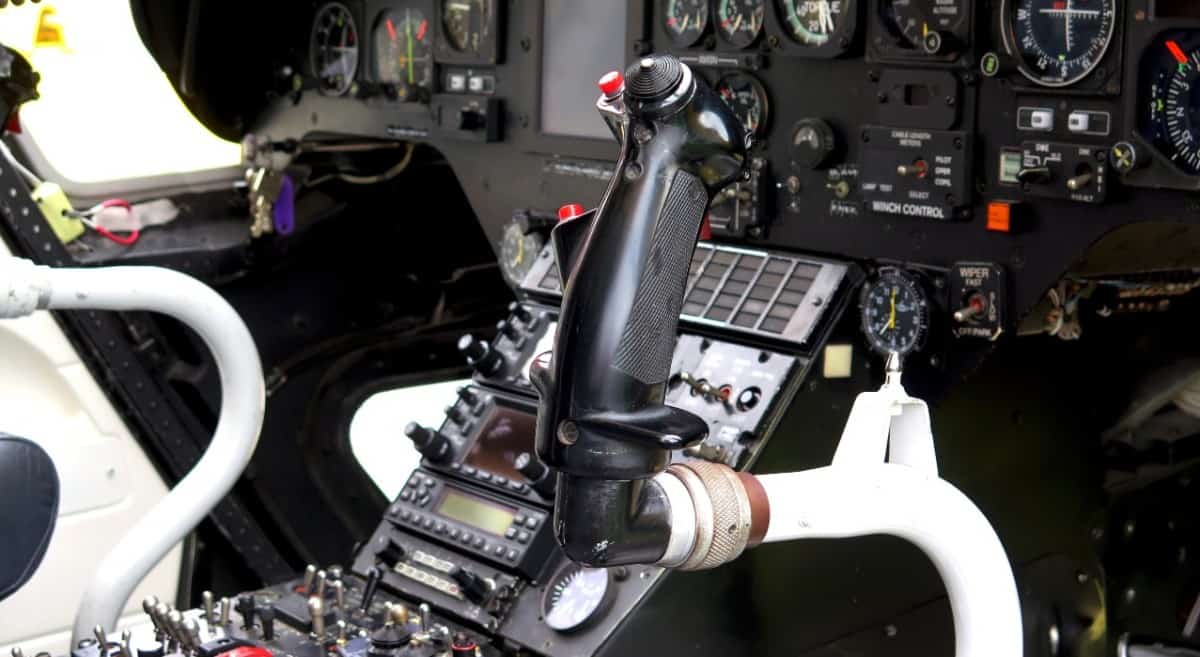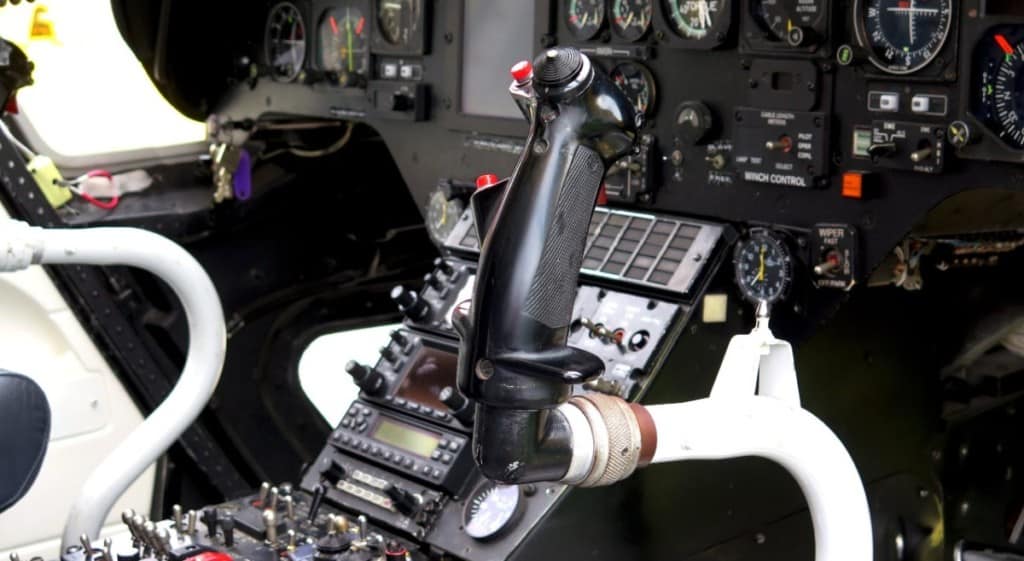
When you first walk up to a helicopter and peer inside you are presented with some odd-looking levers that you know are somehow used to control the thing but are not quite sure how. This was my first thought!
There are 4 pilot-operated controls in a helicopter. The Throttle is used to control the power of the engine. The Pedals turn the helicopter around its mast in a hover. The Collective is used to climb or descend and the Cyclic is used to control the direction the helicopter travels.
Now you have the very basic explanation let’s look at each one in detail so you have a full understanding of how they all work to make one of these things fly!
Pedals
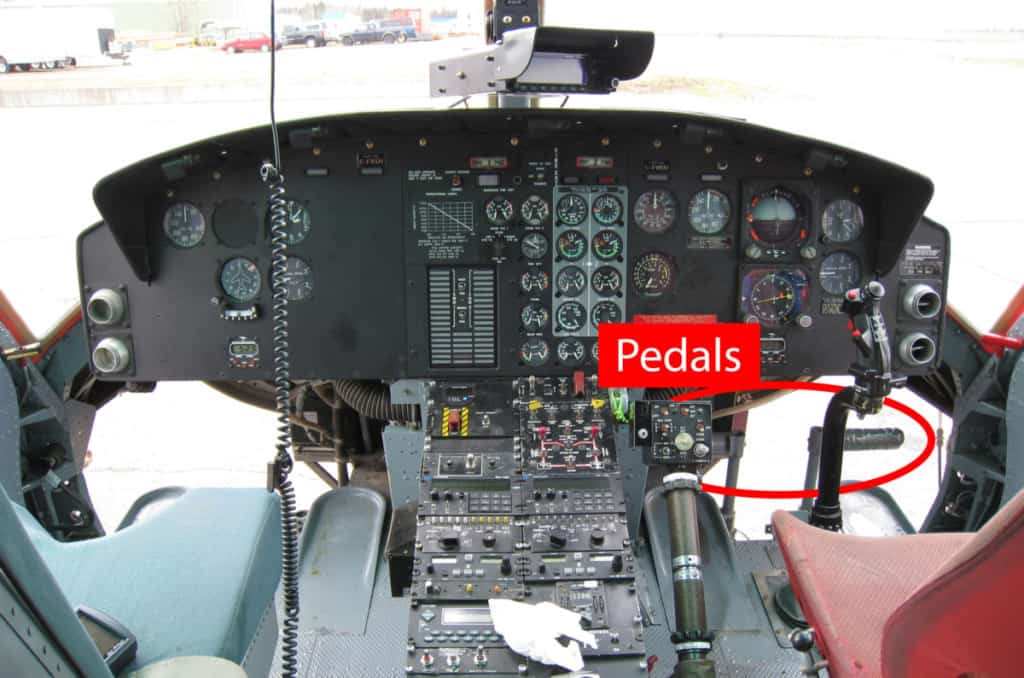
The pedals, also known as ‘Anti-Torque Pedals’ in a helicopter perform two functions depending on which state of flight the helicopter is in:
- In a Hover – Turning
- In Forward Flight – Maintaining Trim
Both pedals are mechanically linked to one other so when the pilot pushes the left pedal away from them, the right pedal will come towards them and vice versa – Think of it like a Teeter-Totter.
The pedals are connected to the blades on the Anti-Torque or Tail Rotor (The rotor at the very back of the aircraft) by a mechanical and/or hydraulic linkage. As the pilot pushes on the pedals, this linkage moves a slider up and down the drive shaft of the tail rotor.
The pedal linkage is connected to a non-rotating side of the slider, while each tail rotor blade is connected to the rotating half of the slider via a Pitch Link.
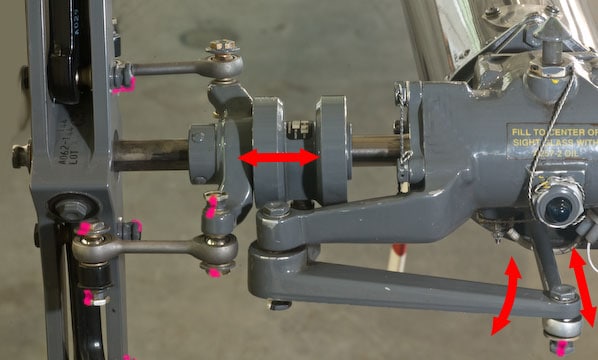
As this slider moves up and down the shaft, it increases or decreases the pitch of all the tail rotor blades together to make them either grip more air or grip less Air. This gripping of air is called Tail Rotor Thrust.
I say grip because airfoils don’t push off air. The upper surface of an airfoil creates negative air pressure, so in essence, an airfoil ‘Sucks’ its way up into the air.
Tail rotor blades are just small airfoils mounted vertically. The more pitch the pilot puts on them via the pedals, the more they suck or grip into the air.
1. In a Hover
This type of a turn is known as a ‘Pedal Turn’ and is around the Yaw Axis of the helicopter. The Yaw axis runs vertically down the Main Rotor Mast. This type of turn is used to point the nose of the helicopter in a specific direction while in a hover or used to turn the helicopter while taxing on the ground if the helicopter has wheels.
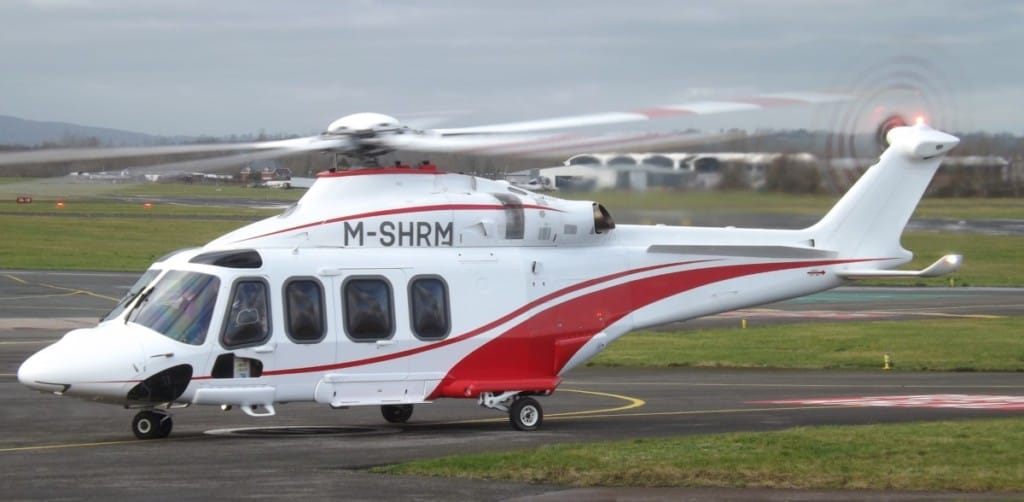
Some Quick Aerodynamic Theory To Set The Picture:
When a helicopter is in a stable hover, all the forces acting on the helicopter are equal, therefore it should not move.
As the engine turns the main rotor in one direction, the fuselage will want to turn in the opposite direction. This is due to Newton’s Third Law:
“For Every Action, There Is An Equal & Opposite Reaction“
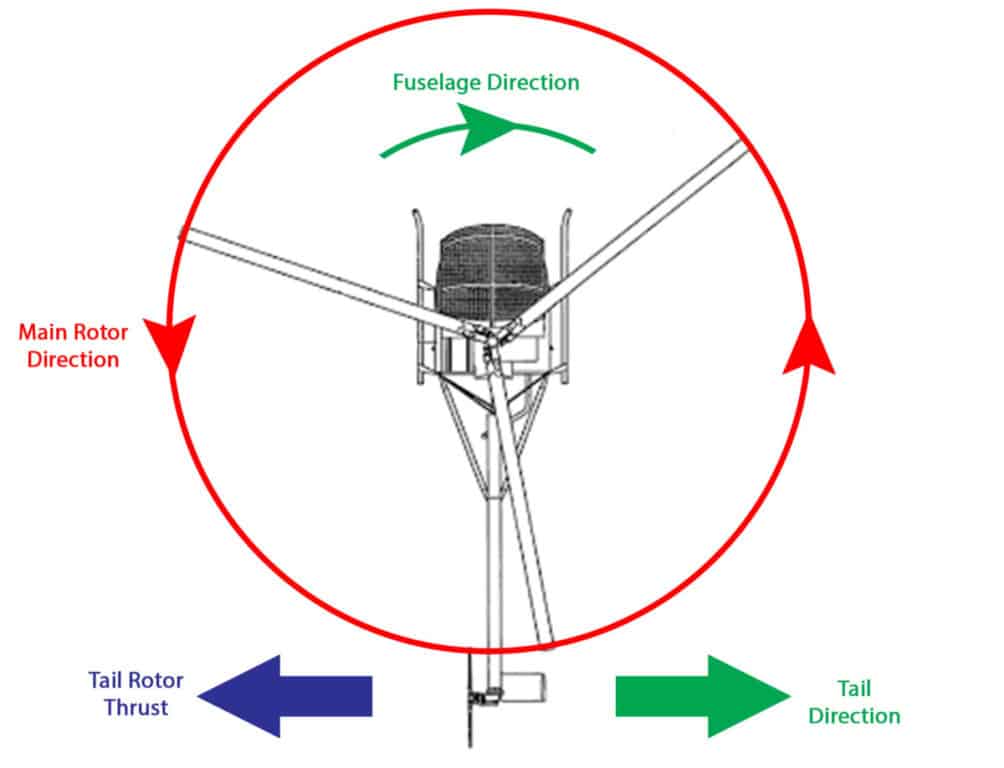
To prevent the helicopter from spinning around, the thrust produced by the tail rotor matches the force of the fuselage wanting to turn. Both forces are now in equilibrium and the helicopter keeps pointing forward.
The next few paragraphs are based on North American-made helicopters like Bell and Sikorsky with a main rotor that rotates counter-clockwise when viewed from above.
European-made helicopters like Eurocopter or Airbus rotate clockwise so the explanations below will be the opposite.
To Turn Left:
While in the hover, if the pilot pushes on the left foot pedal:
- The pitch of the tail rotor will increase on all its rotor blades via a mechanical and/or hydraulic linkage
- As the blades pitch increases, the thrust produced will be greater than the fuselage torque
- This thrust will push the tail of the helicopter to the right, &
- The cockpit of the helicopter will then rotate to the left around the mast of the main rotor until the pedals are centered.
To Turn Right:
While in the hover, if the pilot pushes on the right foot pedal:
- The pitch of the tail rotor will decrease on all its blades
- This thrust produced will be less than the fuselage torque
- The torque will pull the tail of the helicopter to the left
- The cockpit of the helicopter will then rotate to the right around the mast of the main rotor until the pedals are centered
2. In Forward Flight
When a helicopter is in forward flight the pedals are used to keep the tail in line behind the nose of the helicopter, especially when in a banked turn to the left or the right.
This is known as ‘Keeping The Aircraft In Trim’
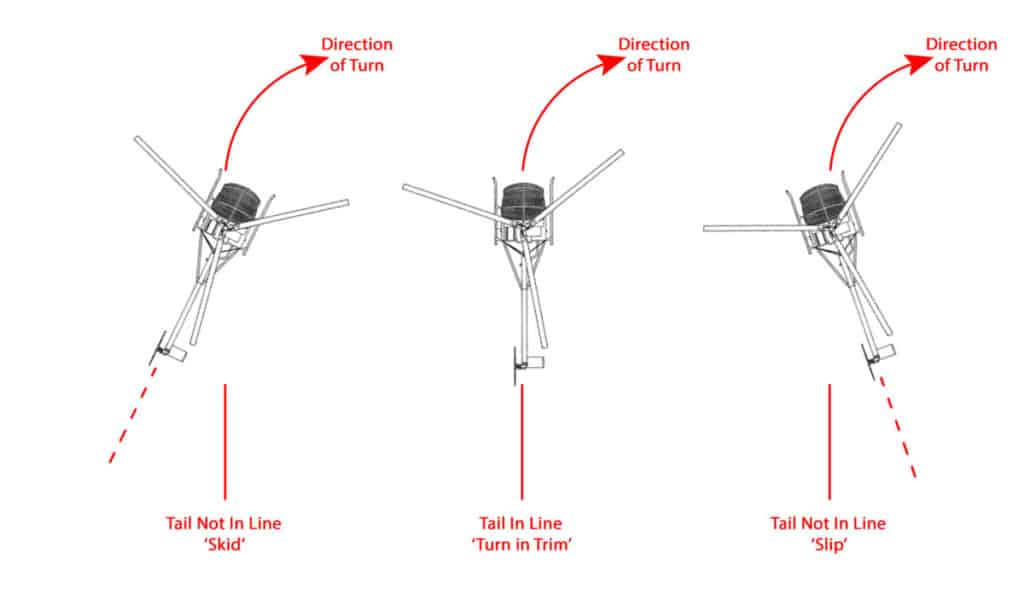
When in a right-hand banked turn for example:
If the pilot puts in too much right pedal, the nose will point into the turn too much and this is known as a Skid.
If the pilot puts in too much left pedal, the nose will point out of the turn too much and this is known as a Slip.
When the pedals are in the right position, the nose points along the path of flight. This is a balanced turn and is ‘In Trim’.

Join My Newsletter & Get Great Tips, Information and Experiences To Help You Become a Superb Pilot!
Cyclic
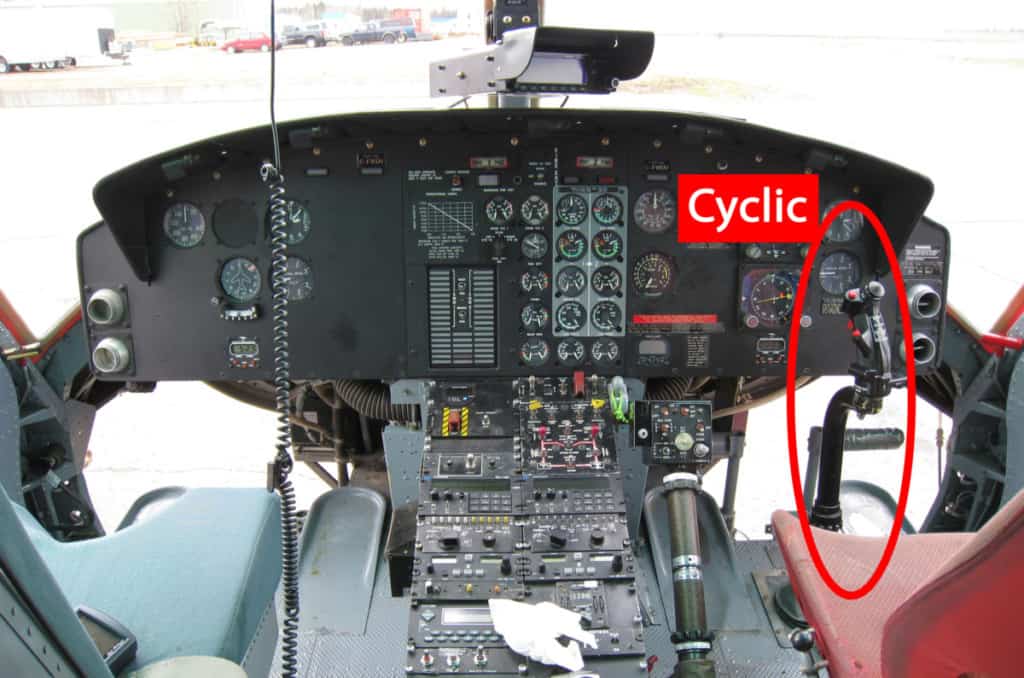
The cyclic control is moved by the pilots right hand and it is used to move the helicopter in any direction over the ground.
- When the pilot pushes left on the cyclic, the helicopter banks slightly left and then moves.
- When the pilot pushes right on the cyclic, the helicopter banks slightly right and then moves.
- When the pilot pushes forward on the cyclic, the helicopter tilts slightly nose down and then moves.
- When the pilot pulls backward on the cyclic, the helicopter tilts slightly nose up and then moves.
- When the Cyclic is centered, the helicopter should not move – Unless the wind pushes it!
When I talk about ‘Move the Cyclic’ it is more like putting pressure on the Cyclic in the direction the pilot wants the helicopter to move. If you watch an experienced pilot you should never really see their right hand moving!
The Cyclic control is connected to a device called a Swashplate that sits on the main rotor mast. This device transfers the movements from the Cyclic to the rotor blades via mechanical and or hydraulic linkages to ‘In effect’ tilt the main rotor ‘disk’. (The main rotors look like a disk when they are spinning).

The Swashplate is made of two halves that work together. The bottom half connects to the Cyclic linkages, or actuators of the helicopter if it has hydraulics or ‘Power Steering’. The top half of the Swashplate rotates and connects to each main rotor blade. As the cyclic is moved by the pilot, the linkages tilt the Swashplate in the direction the Cyclic has been moved.
This video will help you visualize its operation:
Learn More…
Try These Articles:
* A Hovering Helicopter: How Does It Do That?
* Why Do Only Some Helicopters Have Wheels? There are Plenty of Reasons Why!
Most helicopters have 3 linkages connected to the swashplate. The swashplate is used to increase or decrease the pitch angle of each rotor blade. Both the Collective Control and the Cyclic control are connected to the Swashplate via engineering wizardry. (If you have seen the Mixing Unit on a Sikorsky S76A model you will know what I am talking about! – I will try and get a video of it one day. It will blow your mind!)
If the Collective Control (More on this later), is raised or lowered, all the linkages/actuators raise or drop the entire Swashplate together. This increases or decreases the pitch angle on all the main rotor blades ‘Collectively’ so the helicopter climbs or descends.
When the pilot moves the Cyclic Fwd, Aft, Left, or Right, each hydraulic actuator or linkage moves independently to effectively tilt the stationary part of the swashplate in the direction the cyclic was moved.
As the stationary half tilts, the rotating half mirrors the tilt. As each blade rotates around the helicopter, its pitch angle will change according to how the swashplate is tilted.
This is where it gets a little more complex so I hope I can explain this clearly. I’m not going to go into deep fundamentals like the Pendulum Effect, Dissymertry of Lift, Gyroscopic Precession, and things like that as the mantra of this site is in the tagline “Everything Aviation – Simply Explained”
For Example:
If the pilot pushes the Cyclic to the right, the linkages/actuators will raise the Left-hand side of the Swashplate and drop the right-hand side (if you were sat on the tail boom looking forward). This will appear to tilt the rotor disk to the right.
To accomplish this tilting of the disk, when each blade is at the 9 o’clock position the Swashplate is causing the blade to have a high pitch angle, it produces more lift, and causes it to rise.
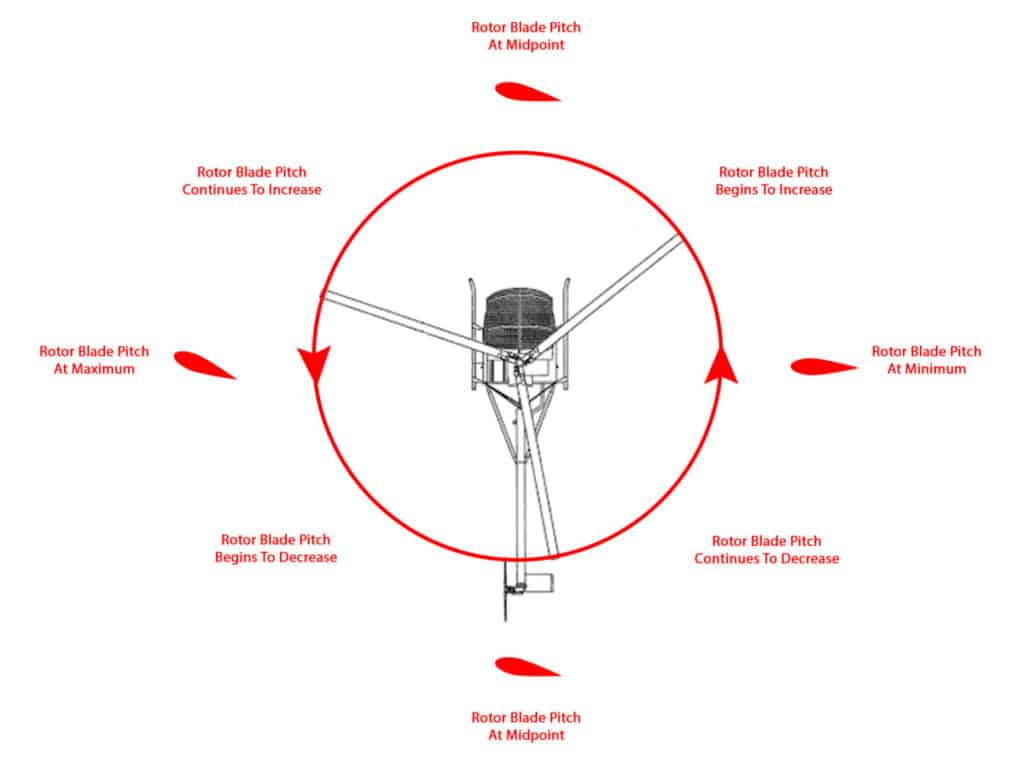
As each blade moves around to the 3 o’clock position it reduces to its flattest pitch angle.
At 12 & 6, each blade is either increasing or decreasing its pitch angle as it rotates.
This is the same for any direction the pilot moves the cyclic. If the pilot wants the aircraft to move forward, the rotor disk raises at the back and drops at the front.
If the pilot wants the aircraft to move left, the rotor disk raises on the right and drops on the left.
By tilting the rotor disk in the direction of travel, the fuselage will follow. The more the cyclic is moved, the further the disk will tilt and the quicker the helicopter will bank and turn or accelerate/decelerate.
I hope I explained that simply enough!!
Collective
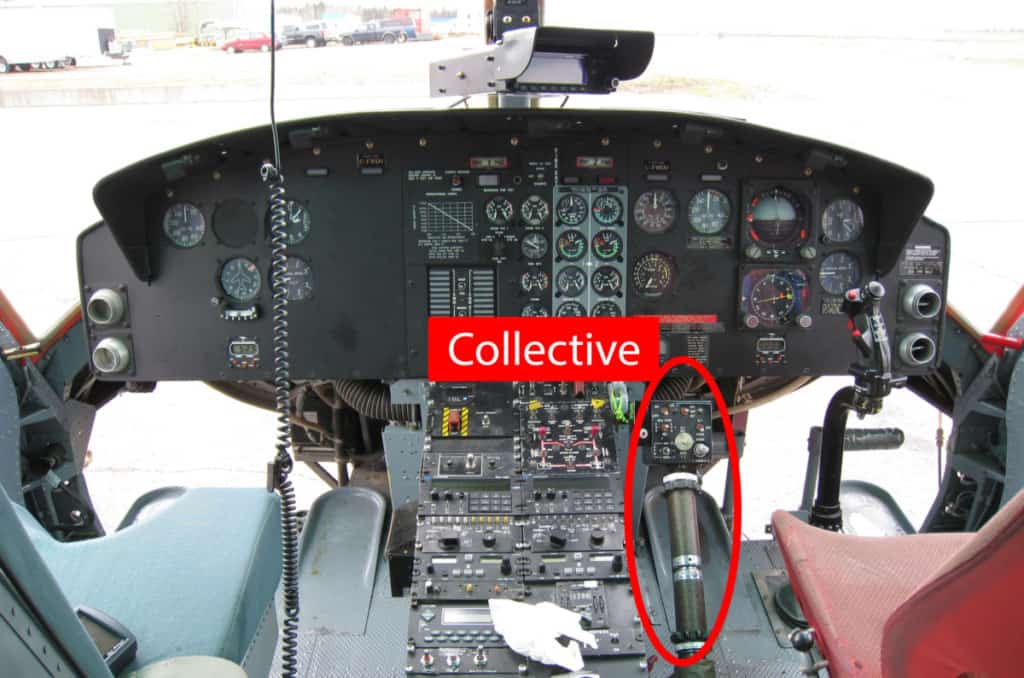
The Collective control is raised and lowered by the pilots left hand. This controls the rate at which the helicopter climbs or descends.
- When the pilot raises the Collective, the helicopter will climb higher
- When the pilot lowers the Collective the helicopter will descend lower
The Collective is connected via linkages and/or hydraulic actuators to both the Swashplate and the fuel control unit on each engine.
Swashplate
As briefly mentioned earlier, the Collective control moves the entire Swashplate up and down, thus changing the pitch angle of all the main rotor blades together.
By increasing all the blades together they all produce more lift at the same time causing the helicopter to begin climbing. The more the Collective is raised, the faster the helicopter will climb.
When the Collective is lowered, the pitch angle is decreased on all the main rotor blades so they all produce less lift at the same time, causing the helicopter to begin descending. The more the Collective is lowered, the faster the helicopter will descend.
This type of control system is very similar in principle to the ‘Slider’ used on the Tail Rotor.
Fuel Control
When the Collective is raised, we know it increases the pitch angle of each rotor blade to increase the lift it produces, but that also increases the drag it creates as it rotates through the air.
Think of putting your hand out of the car window as a kid. When your hand was flat and parallel to the ground it would cut through the air. As you then rotated your palm upwards your hand would want to move up and backward. This is the lift moving it up and the drag moving it back.
As the drag on each rotor blade increases it will begin to slow down how fast that blade travels through the air and thus decrease the Main Rotor RPM. The fuel control unit needs to increase engine power to overcome this drag and maintain the optimum RPM of the Main Rotor.
The opposite happens when the collective is lowered. The drag reduces and if the engine power is not reduced this will allow the Main Rotor RPM to increase and cause what is referred to as a Main Rotor Over-Speed. The higher the RPM during an Over-speed, the higher the centrifugal force will be on all the rotor head components which can lead to failure or premature wear.
By having the Collective directly linked to the engine/s fuel control unit/s, this addition or reduction of power happens automatically as the Collective is raised or lowered.
This is about as basic as I can explain it.
Learn More…
Try These Articles:
* Black Box Flight Recorders: Do Helicopters Have Them?
* How Does Wind Effect a Helicopter? Pilot Tells All!
Throttle
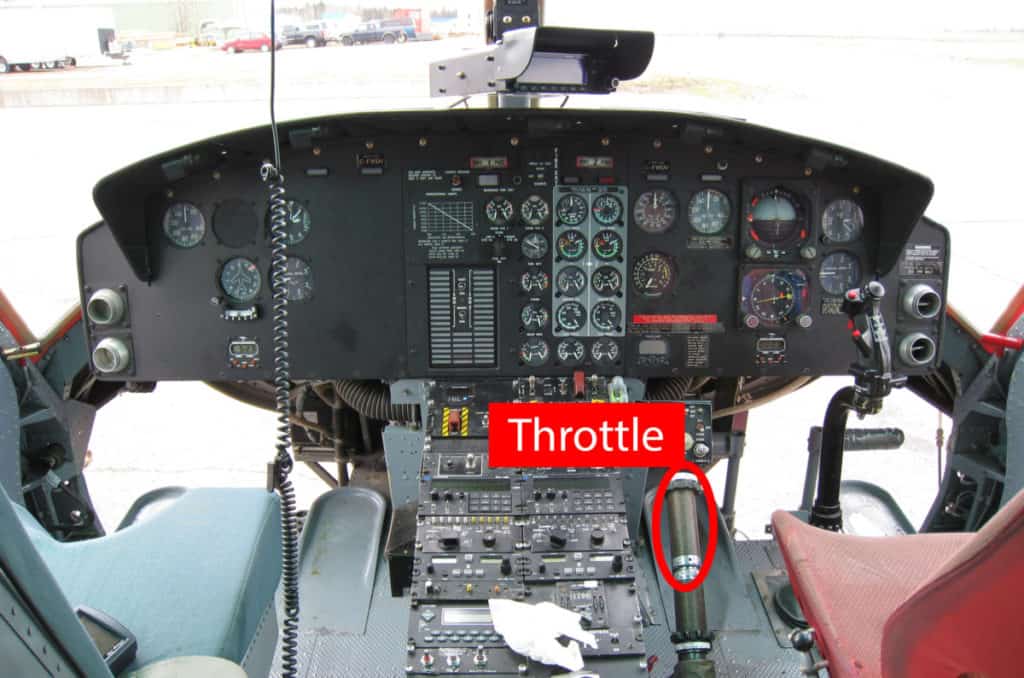
The throttle is just the same as on any vehicle, it is used to control the power output of the engine. The same is true for a helicopter.
The Main Rotor and the Tail Rotor are connected to the main transmission which is driven by the engine/s. As the engine/s turns the gears in the transmission, it turns the Main Rotor and the Tail Rotor together albeit at different speeds. Usually around a 6:1 ratio. For every complete revolution of the Main Rotor, the Tail Rotor will turn 6 revolutions.
All helicopters have an optimum RPM that the main rotor needs to turn at to produce the most lift. This RPM is designed by the helicopter manufacturer.
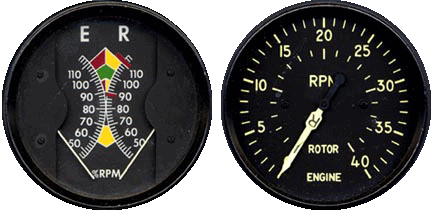
When the pilot starts the helicopter engine/s there are two engine settings the throttle gets set to.
1. Idle
After the initial fire-up of the engine, this is an RPM that the pilot accelerates the engine to and then sets. The purpose of idle is to allow all the aircraft seals, bearing, flight controls, engine/s, and oils to warm up. This is paramount to prevent early fatigue of parts.
Once all the aircraft’s Temperatures and Pressures are beginning to rise this is when the pilot increases the throttle to the final setting – Flight.
Idle is also used to cool down the engine and oils upon landing before shutting the engine off. Most idle times upon landing are set by the engine manufacturer. The Rolls-Royce engine in a Bell 206 Jet Ranger has a 2-minute cooldown idle time, whereas the Arriel engine in a Eurocopter AS350 Astar has a 30-second cool time.
2. Flight
Flight is where the engine RPM is set for take-off. The engine/s increases RPM and sit at the optimum speed for the entire flight. Only the power required from the engine changes during the flight and that is accomplished by the fuel control unit.
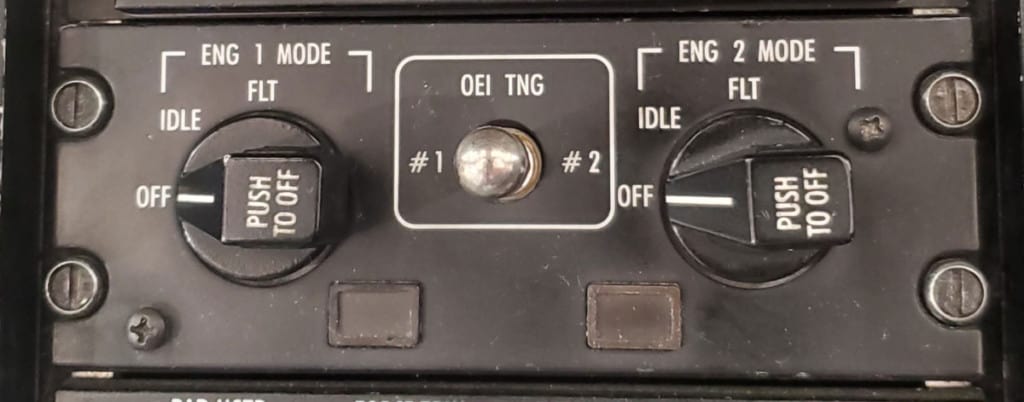
Fuel Control
As the aircraft accelerates or slows down, turns, climbs, and descends, the power needs to be adjusted to overcome the drag created and maintain the Main Rotor RPM. On earlier helicopters like the Bell 47, this adjustment had to be done manually via a twist grip throttle on the end on the Collective Lever. It took some practice to get it balanced!
On most helicopters, it is now done automatically via a mechanical linkage that increases the fuel flow on the fuel control unit when the Collective is raised and reduces fuel flow as the Collective is lowered. This maintains Main Rotor RPM in the ballpark, then some version of electronic governor tweaks the fuel control unit to keep the Main Rotor RPM at the desired speed.
On modern helicopters with digital engine control, the throttle is controlled by the engine computer. These are truly a ‘Set To Flight & Forget’ system that really reduces pilot workload.
To Finish
Once the throttle has been set, the pilot really only has the three flight controls to look after. Pedals, Cyclic & Collective. Each one requires practice to master but the worst part that always makes the beginner pilot sweat is that when you adjust one control, it affects the other two!
Just to maintain a helicopter in a hover is one of the most challenging parts of learning to fly and it usually takes around 10 hours of flight time before a new student begins to keep it somewhat under control! If you have never had a flight in a helicopter I highly recommend you go and book in for a trial flight with an instructor and go try hovering! You will sweat, curse, and laugh! It is great fun!

